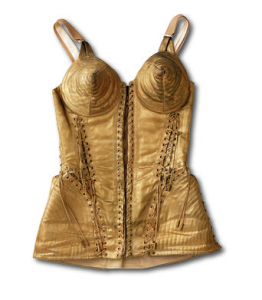An Incomplete History: “Women Who Rock” at the Rock and Roll Hall of Fame
 I found myself in Cleveland last week. My friend Amy Rigby, a musician who plies her trade in one of the parallel music industries that I talked about in my recent post about the Grammy Awards, had things to do in Cleveland. I’d been threatening for months to take advantage of being on sabbatical to see the “Women Who Rock” exhibit at the Rock and Roll Hall of Fame, a few hours from where I live, before it closed on February 26, although the thought of it made me queasy. A road trip was born and Amy and I visited the exhibit. It was all that I expected, which is to say, not much.
I found myself in Cleveland last week. My friend Amy Rigby, a musician who plies her trade in one of the parallel music industries that I talked about in my recent post about the Grammy Awards, had things to do in Cleveland. I’d been threatening for months to take advantage of being on sabbatical to see the “Women Who Rock” exhibit at the Rock and Roll Hall of Fame, a few hours from where I live, before it closed on February 26, although the thought of it made me queasy. A road trip was born and Amy and I visited the exhibit. It was all that I expected, which is to say, not much.
Critiquing it is like shooting fish in a barrel; it’s just too easy. The Rock and Roll Hall of Fame reflects the worldview of Rolling Stone magazine and major players in the commercial music industry. The “meta” issue at play is how to put rock and roll, or any type of music, in a museum. What good is looking and reading about music when you haven’t heard it? Posting individual listening stations at each display would make progress through any exhibit impossibly slow, compromising an institution’s ability to remain financially solvent. Curators have to assume that we know what the music, at least some of it, sounds like. The cultural authorization that results from exhibits of this type is also problematic, as are issues of inclusion and exclusion. Who gets recognized, who doesn’t, and why?
These problems are especially germane to an exhibit about women and rock. I imagine that although some of the people who saw the exhibit were music nerds like me and Amy, most were not. Those of us who are already familiar with the music could “play” it in our heads. What would everyone else do? We were there on the President’s Day holiday, and the majority of visitors in the galleries were either middle-aged couples or moms with their pre- or just-teen daughters. The solution proffered by the Rock Hall was to focus on performers who visitors might be familiar with. Hence a couple of displays devoted to Lady Gaga (the meat dress!), pop stars from the 80s on, the most well-known punk, new wave and “alternative” acts, several rap, hip-hop, and nouveau girl group artists, and some appropriately reverential educational videos about early blueswomen and R&B singers from the 50s and 60s. Emphasis was on singers. “Wait,” you may say, “I thought you were talking about rock?” Indeed. “Rock” here is stretched so thin as to be a meaningless term – a common discursive move. “Rock,” the exhibit claimed, is an attitude, and apparently these selected artists all have it.
We were a bit amazed by some of the performers who were barely recognized, or left out entirely. Wither the Slits? The Raincoats? Poly Styrene? Patsy Cline? Emmylou Harris? Exene? Mo Tucker? Oh yeah, listed in a paragraph on a small sign, maybe. Patti Smith, Debbie Harry, Kim Gordon, Kathleen Hanna, and Liz Phair were there, but where were the rest of the women from the 70s to the 90s and beyond who made or continue to toil in the rock trenches? Where were the non-Americans? (Joni Mitchell was included, but she’s lived south of the 49th parallel for a long time.) Pioneering female rock group Fanny was represented with a group photo on a swinging door that led to a side exhibit; Amy and I were relieved that it was not the entrance to the restroom, which is what it looked like.
After a while, it seemed that artists who were able to donate “stuff,” usually in the form of stage attire identified by the name of the designer, were the de facto focal points of the exhibit. That wasn’t necessarily the case, as it turns out. Upon my return, I asked June Millington of Fanny whether she’d been contacted about the exhibit. She hadn’t, although she knew that her photo was being used and that the curatorial staff had her contact information. Too bad, as Millington has plenty of stuff, in the way of guitars, other instruments, and memorabilia that I’m sure she’d have been happy to lend and that could have formed part of more interesting exhibits. (I also emailed one of the Raincoats with the same question; if I get a response I’ll post her answer in the comments to this piece.)
The exhibit was accompanied by a PBS documentary, so upon my return home I watched that, hoping that it would fill in some blanks. I’m sorry to say that it did not. (It streams here: http://video.pbs.org/video/2168854975). Although narrated by leading male and female critics, and hosted by Cindy Lauper, it omitted even more artists in order to create a smooth narrative from Bessie Smith to Janelle Monae, culminating in an implied celebration of “poptimism,” currently a vogue amongst writers, bloggers and some academics who think critically about popular music. I think that the critical turn to poptimism is well intentioned, as it attempts to break down hackneyed binaries that as much as we don’t want them to continue to inform discussions of popular music (e.g., authentic/commercial, male/female, white/black, rock/pop), but believe it does not deal adequately with other things, for example: the political economy of the industries; entrenched sexism; the tyranny of playlists, Pitchfork, and tightly constructed radio formats that shut down possibilities for artists like Amy, a long-time critical favorite whose music has always fallen between the cracks; the tracking of women away from rock and into softer or more “appropriate” pop listening practices as they age; the myth of the “middle-class musician” who can actually afford things like health care and a guarantee of a decent living; and the politics of representation and identity in their myriad configurations.[1]
Calling it all “rock” does not attenuate or explore these and other issues. Ultimately, the story of “women who rock” is not all about clothes and good feelings. Writing so much and so many out of what could, because of its institutional status, become the foundation of the sanctioned and commonsense history of women and rock threatens to erase or trivialize their past, present and future contributions. We scholars and critics have our work cut out for us if we want to capture the more inclusive and nuanced history that the subject deserves.
[1] Yes, this is a bit of a shameless advertisement for Amy, a woman who most definitely rocks yet is, in my opinion, criminally unknown. Check out her music and blog at www.amyrigby.com, or legally download her albums from Emusic.com or iTunes.


